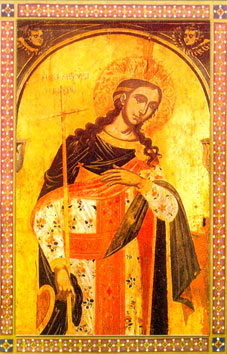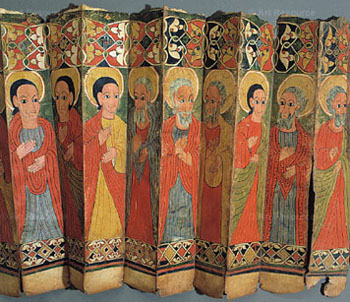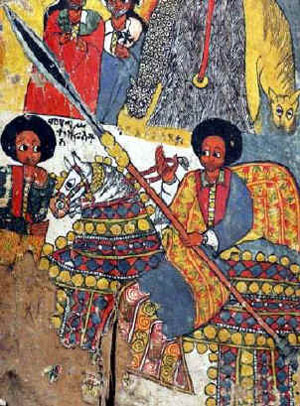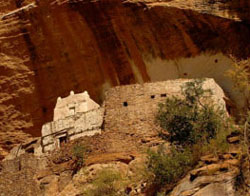St Moses the Ethiopian
St Moses the Ethiopian was a former gang leader, murderer, and thief in ancient Africa. However, he became a model of transformation. His is one of the most inspiring stories among the African saints.
Moses, an escaped slave, was the leader of a group of 75 robbers. He was a large and powerful man, who with his gang terrorized the entire region. Moses was transformed after he and his group attacked a monastery, intending to rob it. He was met by the abbot, whose peaceful and warm manner overwhelmed him. He immediately felt remorse for all his past sins, sincerely repented, and begged to remain at the monastery.
Moses was tortured by his past and for years was tempted to return to his old ways. One day, as he was confessing his sins to St. Macarius, an angel appeared with a tablet full of his sins. As he confessed, the angel began wiping the tablet clean. The more he confessed, the more the angel wiped, until by the end it was completely clean. After meeting St. Macarius and St. Isidore, he completely left his old ways behind him and became a monk.
Later, St. Moses was ordained to the priesthood -- a rare honor among the Desert Fathers -- and founded a monastery of 75 monks, the same number as his former group of thieves. He was known for his wisdom, humility, love, and non-judgment of others. Once a brother had been caught in a particular sin, and the abbot asked St. Moses to come to the church and render judgment. He came reluctantly, carrying on his back a leaking bag of sand. When he arrived, the brothers asked him why he was carrying such a thing. He simply said, "This sand is my sins which are trailing out behind me, while I go to judge the sins of another." At that reply, the brothers forgave the offender and returned to focusing on their own salvation rather than the sins of their brother.
In 405 A.D., at age 75, St. Moses suffered a martyr's death, when his monastery was attacked by a group of barbarians. He is remembered on the 28th of August. He is the patron saint of our brotherhood.
| Phoro from here |
Coptic movie about st. Moses the Ethiopian (video)
An orthodox hymn (apolytikion) to st. Moses the Ethiopian (in Greek - from here):
Other Ethiopian saints in Eastern Orthodox Church
Martyr Djan Darada (or Simeon Bachos), the Ethiopian eunuch of Queen Candace (Feast day August 27).
From here
The Ethiopian eunuch is a figure in the New Testament of the Bible. The story of his conversion to Christianity is recounted in Acts 8.
Biblical narrative
Philip the Evangelist was told by an angel to go to the road from Jerusalem to Gaza, and there he met the Ethiopian eunuch. He had been to Jerusalem to worship (Acts 8:27), and was returning home. The eunuch was sitting in his chariot reading the Book of Isaiah, and had come to Isaiah 53:7-8. Philip asked the Ethiopian, "Do you understand what you are reading?" He said he did not ("How can I understand unless I have a teacher to teach me?"), and asked Philip to explain the text to him. Philip told him the Gospel of Jesus, and the Ethiopian asked to be baptized. They went down into some water and Philip baptized him.
In the King James Version and the Catholic Douay-Rheims Version, the Ethiopian says, "I believe that Jesus Christ is the Son of God" (verse 37), but this is omitted in most modern versions. Hubbard suggests that confession is "not supported in the better manuscripts [i.e. the Alexandrian text-type])", although the Ethiopian is still "one of the outstanding converts in Acts."[1]
After this, Philip was suddenly taken away by the Spirit of the Lord, and the eunuch "went on his way rejoicing" (verse 39).
Christian traditions
Church Father St. Irenaeus of Lyons in his book Adversus haereses (Against the Heresies, an early anti-Gnostic theological work) 3:12:8 (180 AD), wrote regarding the Ethiopian eunuch, "This man (Simeon Bachos the Eunuch) was also sent into the regions of Ethiopia, to preach what he had himself believed, that there was one God preached by the prophets, but that the Son of this (God) had already made (His) appearance in human flesh, and had been led as a sheep to the slaughter; and all the other statements which the prophets made regarding Him." In Ethiopian Orthodox Tewahedo tradition he was referred to as Bachos and in Eastern Orthodox tradition he is known as an Ethiopian Jew with the name Simeon also called the Black, the same name he is given in Acts 13:1.[2][3]
Assessment and interpretation
The Ethiopian is described as a eunuch and a treasury official at the court of Queen Candace (Acts 8:27). D. A. Hubbard suggests that he may have been a proselyte,[1] though Paul Mumo Kisau argues that he was a Godfearer instead.[4] Scott Shauf suggests that the "primary point of the story is about carrying the gospel to the end of the earth, not about establishing a mission to Gentiles," and thus Luke "does not bring the Gentile status of the Ethiopian into the foreground." However, "the suggestion that the eunuch is or at least might be a Gentile in the story, by both his ethnic and possibly physical description, serves to tantalize the reader with the mystery of the situation."[5] The eunuch may have been from Nubia or the Sudan: David Tuesday Adamo suggests that the word used here (Αίθίοψ, aithiops) is best translated simply as "African."[6]
Commentators generally suggest that the combination of "eunuch" together with the title "court official" indicates a literal eunuch, who would have been excluded from the Temple by the restriction in Deuteronomy 23:1.[7][8] Some scholars point out that eunuchs were excluded from Jewish worship and extend the New Testament's inclusion of these men to other sexual minorities; John J. McNeill, citing non-literal uses of "eunuch" in other New Testament passages such as Matthew 19:12,[9] suggests that this eunuch was "the first baptized gay Christian,"[10] while Jack Rogers writes that "the fact that the first Gentile convert to Christianity is from a sexual minority and a different race, ethnicity and nationality together"[11]:135 calls Christians to be radically inclusive and welcoming.
C. K. Barrett contrasts the Ethiopian eunuch's story with that of Cornelius the Centurion, another convert. He notes that while the Ethiopian continues on his journey home and passes out of the narrative, Cornelius and his followers form another church in Judea, and speculates that this reflects a desire to focus on Peter rather than Philip.[15] Robert O'Toole argues that the way Philip is taken away parallels the way Jesus disappears after he has been talking to the disciples on the road to Emmaus in Luke 24.[16]
St. Fulvian-Matthew, King of Ethiopia
From the biography of the Apostle & Evangelist Matthew
The holy Apostle brought the Gospel of Christ to Syria, Media, Persia, Parthia, and finishing his preaching in Ethiopia with a martyr’s death. The holy Apostle Matthew converted some of the idol-worshippers to faith in Christ. He founded the Church and built a temple in the city of Mirmena, establishing there his companion Platon as bishop.
When the holy apostle was fervently entreating God for the conversion of the Ethiopians the Lord Himself appeared to him in the form of a youth. He gave him a staff, and commanded him to plant it at the doors of the church. The Lord said that a tree would grow from this staff and it would bear fruit, and from its roots would flow a stream of water. When the Ethiopians washed themselves in the water and ate the fruit, they lost their wild ways and became gentle and good.
When the holy apostle carried the staff towards the church, he was met by the wife and son of the ruler of the land, Fulvian, who were afflicted by unclean spirits. In the Name of Christ the holy apostle healed them. This miracle converted a number of the pagans to the Lord. But the ruler did not want his subjects to become Christians and cease worshiping the pagan gods. He accused the apostle of sorcery and gave orders to execute him.
They put St Matthew head downwards, piled up brushwood and ignited it. When the fire flared up, everyone then saw that the fire did not harm St Matthew. Then Fulvian gave orders to add more wood to the fire, and frenzied with boldness, he commanded to set up twelve idols around the fire. But the flames melted the idols and flared up toward Fulvian. The frightened Ethiopian turned to the saint with an entreaty for mercy, and by the prayer of the martyr the flame went out. The body of the holy apostle remained unharmed, and he departed to the Lord.
The ruler Fulvian deeply repented of his deed, but still he had doubts. By his command, they put the body of St Matthew into an iron coffin and threw it into the sea. In doing this Fulvian said that if the God of Matthew would preserve the body of the apostle in the water as He preserved him in the fire, then this would be proper reason to worship this One True God.
That night the Apostle Matthew appeared to Bishop Platon in a dream, and commanded him to go with clergy to the shore of the sea and to find his body there. The righteous Fulvian and his retinue went with the bishop to the shore of the sea. The coffin carried by the waves was taken to the church built by the apostle. Then Fulvian begged forgiveness of the holy Apostle Matthew, after which Bishop Platon baptized him, giving him the name Matthew in obedience to a command of God.
Soon St Fulvian-Matthew abdicated his rule and became a presbyter. Upon the death of Bishop Platon, the Apostle Matthew appeared to him and exhorted him to head the Ethiopian Church. Having become a bishop, St Fulvian-Matthew toiled at preaching the Word of God, continuing the work of his heavenly patron.
St Christodoulos the martyr, an Ethiopian slave
From the biography of st Kerkyra the princess & virgin-martyr
By Fr. George Papavarnavas (from here)
 |
| St Kerkyra (icon from here) |
The Apostles Jason and Sosipater did not cease preaching the Gospel even in prison, and in this way they managed to attract seven famous bandits of the island to the faith, as well as the prison guard Anthony and the daughter of Kerkyllinos named Kerkyra. The fact that Kerkyra became a Christian made a significant impression on the people, thus increasing significantly the number of believers on the island. When Kerkyllinos was informed about this, he called for his daughter and tried to dissuade her. This proved impossible, so in great anger he order her imprisonment, and even went so far as to send to the prison an Ethiopian to corrupt her. But once the Ethiopian approached the door of the prison he was attacked by a beast and seriously wounded. The Saint by her prayers healed him and he was then catechized. The result was that he became a confessor of the true faith and a martyr of Christ. [NOTE of our weblog:
In my opinion, he is the st. Christodoulos the Ethiopian. His martyrdom occurred in the 1st century AD].
Saint Kerkyra was tortured hard by her pagan father, and thus once again was verified the words of Christ: "Your enemies will be those of your own household". She remained "faithful unto death". They killed her with arrows and in this way she delivered her holy soul "into the hands of the living God".
St Elesbaan, King of Ethiopia

A
few of the Saints: ( l – r from lthe bottom) Sophia, Fulvainus-Matthew,
Anthony, Elesbaan, Moses the Ethiopian, Cyprian, Djan-Darada, Maurice,
Athanasius, and Mary of Egypt. (thanks to Bro. John Norman, the
Brotherhood of St. Moses the Black Detroit Chapter, and St Innocent
Orthodox Church in Redford MI). Icon from here.
From this Roman Catholic site
In the 6th century Ethiopia was ruled by the black King St. Kaleb or Elesbaan (after he became a hermit), who was raised from childhood in the Catholic Faith [Note of our weblog: Catholic = Orthodox, not Roman Catholic]. King Elesbaan ruled his country with wisdom and was esteemed by his people.
At that time Ethiopia was part of the Eastern Roman Empire, under Justinian I. Across the Red Sea, Arabia had fallen to Dunaan, a King who apostatized from the Catholic Faith and adhered to Judaism. He was a despotic ruler, persecuting the Bishops and clergy and destroying the churches or transforming them into synagogues. St. Gregentius, Bishop of Tafas, was expelled from his diocese; St. Aretas, governor of Nagran and leader of the Catholic reaction, was beheaded along with his wife, children and 340 of his people. Around 4,000 Catholics [=Orthodox] were killed without trial after suffering many cruelties.
Emperor Justinian called on King Elesbaan to chastise the usurper. The King gathered his army and crossed the Red Sea to punish the affront to Catholic [=Orthodox] honor. Elesbaan landed in Arabia, defeated Dunaan and executed him. Then he restored St. Gregentius to his episcopal see, rebuilt the churches and remained in the country until Ebrahamos, who was Catholic [=Orthodox], was elected King of the Arabs.
Once his mission of justice and peace was accomplished, he returned to Ethiopia and ruled there for some years more, carefully instructing his son in the Catholic [=Orthodox] Religion and the direction of the Kingdom. Then he renounced his title and turned over the Kingdom to his son.
[=Orthodox] Religion and the direction of the Kingdom. Then he renounced his title and turned over the Kingdom to his son.
Disguised as a hermit, he retired to a monastery in the mountains. There he lived as a simple religious dedicated to prayer, obedience and work.
He died with a reputation of sanctity on October 27, 532. Often he is pictured as a solitary hermit holding a cross and with a crown at his feet.
Comments of Prof. Plinio:
I think the life of St. Elesbaan has a special beauty reflecting an aspect of the life of the Church that appears especially in the Eastern Catholic Church [=Orthodox Church]. This aspect is linked to a type of life that was frequent then, the lifestyle of the Anchorite or the Hermit – those early monks living in the desert, one of whom was St. Elesbaan. That solitary life in the desert was very beautiful, abounding in the supernatural, filled with light, and profoundly contemplative. It was shrouded in the prestige of solitude and mystery that surround those peoples of the East.
 |
The Ethiopia of that time was ruled by a great Catholic [=Orthodox] King. He was the most important figure for the life of his country: a just ruler, a great warrior, a wise father who educated his son to succeed him on his throne. After abandoning the kingship, he retired to the desert.
This great King was also a crusader. The word crusader was not actually used in this selection, but he was a de facto crusader. Indeed, the religious persecution that had started in Arabia was instigated by a fanatic of the Jewish sect that was promoting errors and destroying the Catholic [=Orthodox] Church in southern Arabia, today’s Yemen. The Emperor of the Eastern Roman Empire, who was a kind of suzerain over the King of Ethiopia, ordered King Elesbaan to smash that error and to end the persecution.
On the west banks of the Red Sea, there was a Christendom established in Ethiopia where St. Elesbaan shone like a star. On the east banks was an Arabia where the cloud of error and fanaticism loomed. The Arabia of that time had many saints who - because they were faithful to the Catholic [=Orthodox] Faith - were persecuted, deposed or martyred.
 |
This happened in the 6th century. Two centuries before, St. Frumentius had converted Ethiopia to Catholicism [=Orthodoxy], and it became a fertile ground where many saints bloomed, one of them St. Elesbaan. In the 7th and 8th centuries, a good part of the Eastern Roman Empire – including Ethiopia – would fall under Muslim dominion. For many centuries, the religious situation was confused.
When Ethiopia emerged from that dark period, it was Monophysisist, as it is today. This heresy denies that Our Lord Jesus had two natures - human and divine - and pretends that He had only one nature (mono physis).
Note of our blog: Please, see "Oriental Orthodox".
From the life of St. Elesbaan we can draw three conclusions:
First, we in the West often imagine that those Eastern peoples are not called to be a part of the Catholic Church. We have a tendency to consider the Church as a Latin phenomenon. This is absolutely wrong. Before our country [Brazil] was discovered in 1500, before Portugal was born in 1128, before any crusade was raised in the West - many centuries before all this - the Catholic [=Orthodox] Church was present in Ethiopia. A luminous Christendom was alive, shining with many saints and giving God much glory.
You can see, therefore, that all peoples have a vocation to belong to the Catholic Church. To be faithful to the Catholic Faith requires only one condition: to correspond to divine grace. Any people can reach its apex under the Catholic [=Orthodox] Church.
 |
Third, his life gives us an example of the magnificent role of the black race, the black psychology, as an element of culture in the world. To understand the vocation of the black people, we should not think of the pragmatic blacks like many of those we see in the United States who crave to be modern, keeping up with Western fashions and modern technology. Rather, we should imagine the black Magi King, Balthazar, who followed the Star from the East to the Manger to pay homage to the Divine Infant. This King in fact represented a large part of the Gentiles. He is a figure of great prestige, mystery and elevation of spirit.
Note of our blog
About ancient Catholic Church (Orthodox Church, before the Papacy), please see:
Basic Points of Difference between the Orthodox Church and Papism (Catholic Church)
The ancient Christian Church - About Orthodox Church in the West World...
The Way - An introduction to the Orthodox Faith
Theosis (deification): The True Purpose of Human Life
The significance of the “Antilytron”





Δεν υπάρχουν σχόλια:
Δημοσίευση σχολίου